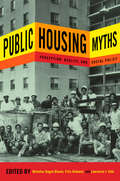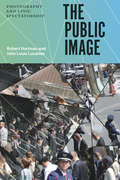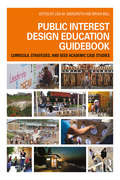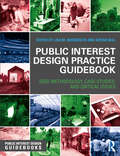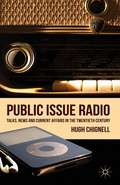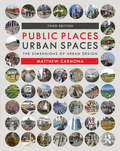- Table View
- List View
Public History: A Practical Guide
by Faye SayerPublic History: A Practical Guide explores history in the public sphere and examines the variety of skills that historians require in the practice of public history. It discusses how through various mediums of interpretation and presentation a range of actors, which include museums, archives, government agencies, community history societies and the media and digital media, make history accessible to a wider audience. It provides the reader with an overview of the wider-world application and communication of history beyond the classroom through core case studies for each sector that include ideas for best practice 'in the field'.This book offers an accessible and engaging synopsis of a topic that has not previously been covered. By focusing on an area of study that has changed substantially in the last decade, Public History: A Practical Guide presents a comprehensive outline of the practice of 'public history', and provides ideas for future methodological approaches as well as a reference point for planning professional development in order to gain future employment in these sectors.In the current economic climate, students need to understand the potential use of history beyond university; this book contains the tools and advice needed for them to get one step ahead in terms of knowledge, skills and experience.
Public Housing Myths: Perception, Reality, and Social Policy
Popular opinion holds that public housing is a failure; so what more needs to be said about seventy-five years of dashed hopes and destructive policies? Over the past decade, however, historians and social scientists have quietly exploded the common wisdom about public housing. Public Housing Myths pulls together these fresh perspectives and unexpected findings into a single volume to provide an updated, panoramic view of public housing. With eleven chapters by prominent scholars, the collection not only covers a groundbreaking range of public housing issues transnationally but also does so in a revisionist and provocative manner. With students in mind, Public Housing Myths is organized thematically around popular preconceptions and myths about the policies surrounding big city public housing, the places themselves, and the people who call them home. The authors challenge narratives of inevitable decline, architectural determinism, and rampant criminality that have shaped earlier accounts and still dominate public perception.
The Public Image: Photography and Civic Spectatorship
by Robert Hariman John Louis LucaitesEven as the media environment has changed dramatically in recent years, one thing at least remains true: photographs are everywhere. From professional news photos to smartphone selfies, images have become part of the fabric of modern life. And that may be the problem. Even as photography bears witness, it provokes anxieties about fraudulent representation; even as it evokes compassion, it prompts anxieties about excessive exposure. Parents and pundits alike worry about the unprecedented media saturation that transforms society into an image world. And yet a great news photo can still stop us in our tracks, and the ever-expanding photographic archive documents an era of continuous change. By confronting these conflicted reactions to photography, Robert Hariman and John Louis Lucaites make the case for a fundamental shift in understanding photography and public culture. In place of suspicions about the medium’s capacity for distraction, deception, and manipulation, they suggest how it can provide resources for democratic communication and thoughtful reflection about contemporary social problems. The key to living well in the image world is to unlock photography from viewing habits that inhibit robust civic spectatorship. Through insightful interpretations of dozens of news images, The Public Image reveals how the artistry of the still image can inform, challenge, and guide reflection regarding endemic violence, environmental degradation, income inequity, and other chronic problems that will define the twenty-first century. By shifting from conventional suspicions to a renewed encounter with the image, we are challenged to see more deeply on behalf of a richer life for all, and to acknowledge our obligations as spectators who are, crucially, also citizens.
The Public Image: Photography and Civic Spectatorship
by Robert Hariman John Louis LucaitesEven as the media environment has changed dramatically in recent years, one thing at least remains true: photographs are everywhere. From professional news photos to smartphone selfies, images have become part of the fabric of modern life. And that may be the problem. Even as photography bears witness, it provokes anxieties about fraudulent representation; even as it evokes compassion, it prompts anxieties about excessive exposure. Parents and pundits alike worry about the unprecedented media saturation that transforms society into an image world. And yet a great news photo can still stop us in our tracks, and the ever-expanding photographic archive documents an era of continuous change. By confronting these conflicted reactions to photography, Robert Hariman and John Louis Lucaites make the case for a fundamental shift in understanding photography and public culture. In place of suspicions about the medium’s capacity for distraction, deception, and manipulation, they suggest how it can provide resources for democratic communication and thoughtful reflection about contemporary social problems. The key to living well in the image world is to unlock photography from viewing habits that inhibit robust civic spectatorship. Through insightful interpretations of dozens of news images, The Public Image reveals how the artistry of the still image can inform, challenge, and guide reflection regarding endemic violence, environmental degradation, income inequity, and other chronic problems that will define the twenty-first century. By shifting from conventional suspicions to a renewed encounter with the image, we are challenged to see more deeply on behalf of a richer life for all, and to acknowledge our obligations as spectators who are, crucially, also citizens.
The Public Image: Photography and Civic Spectatorship
by Robert Hariman John Louis LucaitesEven as the media environment has changed dramatically in recent years, one thing at least remains true: photographs are everywhere. From professional news photos to smartphone selfies, images have become part of the fabric of modern life. And that may be the problem. Even as photography bears witness, it provokes anxieties about fraudulent representation; even as it evokes compassion, it prompts anxieties about excessive exposure. Parents and pundits alike worry about the unprecedented media saturation that transforms society into an image world. And yet a great news photo can still stop us in our tracks, and the ever-expanding photographic archive documents an era of continuous change. By confronting these conflicted reactions to photography, Robert Hariman and John Louis Lucaites make the case for a fundamental shift in understanding photography and public culture. In place of suspicions about the medium’s capacity for distraction, deception, and manipulation, they suggest how it can provide resources for democratic communication and thoughtful reflection about contemporary social problems. The key to living well in the image world is to unlock photography from viewing habits that inhibit robust civic spectatorship. Through insightful interpretations of dozens of news images, The Public Image reveals how the artistry of the still image can inform, challenge, and guide reflection regarding endemic violence, environmental degradation, income inequity, and other chronic problems that will define the twenty-first century. By shifting from conventional suspicions to a renewed encounter with the image, we are challenged to see more deeply on behalf of a richer life for all, and to acknowledge our obligations as spectators who are, crucially, also citizens.
The Public Image: Photography and Civic Spectatorship
by Robert Hariman John Louis LucaitesEven as the media environment has changed dramatically in recent years, one thing at least remains true: photographs are everywhere. From professional news photos to smartphone selfies, images have become part of the fabric of modern life. And that may be the problem. Even as photography bears witness, it provokes anxieties about fraudulent representation; even as it evokes compassion, it prompts anxieties about excessive exposure. Parents and pundits alike worry about the unprecedented media saturation that transforms society into an image world. And yet a great news photo can still stop us in our tracks, and the ever-expanding photographic archive documents an era of continuous change. By confronting these conflicted reactions to photography, Robert Hariman and John Louis Lucaites make the case for a fundamental shift in understanding photography and public culture. In place of suspicions about the medium’s capacity for distraction, deception, and manipulation, they suggest how it can provide resources for democratic communication and thoughtful reflection about contemporary social problems. The key to living well in the image world is to unlock photography from viewing habits that inhibit robust civic spectatorship. Through insightful interpretations of dozens of news images, The Public Image reveals how the artistry of the still image can inform, challenge, and guide reflection regarding endemic violence, environmental degradation, income inequity, and other chronic problems that will define the twenty-first century. By shifting from conventional suspicions to a renewed encounter with the image, we are challenged to see more deeply on behalf of a richer life for all, and to acknowledge our obligations as spectators who are, crucially, also citizens.
Public Images: Celebrity, Photojournalism, and the Making of the Tabloid Press (Photography, History: History, Photography)
by Ryan LinkofThe stolen snapshot is a staple of the modern tabloid press, as ubiquitous as it is notorious. The first in-depth history of British tabloid photojournalism, this book explores the origin of the unauthorised celebrity photograph in the early 20th century, tracing its rise in the 1900s through to the first legal trial concerning the right to privacy from photographers shortly after the Second World War. Packed with case studies from the glamorous to the infamous, the book argues that the candid snap was a tabloid innovation that drew its power from Britain's unique class tensions. Used by papers such as the Daily Mirror and Daily Sketch as a vehicle of mass communication, this new form of image played an important and often overlooked role in constructing the idea of the press photographer as a documentary eyewitness. From Edward VIII and Wallis Simpson to aristocratic debutantes Lady Diana Cooper and Margaret Whigham, the rage of the social elite at being pictured so intimately without permission was matched only by the fascination of working class readers, while the relationship of the British press to social, economic and political power was changed forever.Initially pioneered in the metropole, tabloid-style photojournalism soon penetrated the journalistic culture of most of the globe. This in-depth account of its social and cultural history is an invaluable source of new research for historians of photography, journalism, visual culture, media and celebrity studies.
Public Images: Celebrity, Photojournalism, and the Making of the Tabloid Press (Photography, History: History, Photography)
by Ryan LinkofThe stolen snapshot is a staple of the modern tabloid press, as ubiquitous as it is notorious. The first in-depth history of British tabloid photojournalism, this book explores the origin of the unauthorised celebrity photograph in the early 20th century, tracing its rise in the 1900s through to the first legal trial concerning the right to privacy from photographers shortly after the Second World War. Packed with case studies from the glamorous to the infamous, the book argues that the candid snap was a tabloid innovation that drew its power from Britain's unique class tensions. Used by papers such as the Daily Mirror and Daily Sketch as a vehicle of mass communication, this new form of image played an important and often overlooked role in constructing the idea of the press photographer as a documentary eyewitness. From Edward VIII and Wallis Simpson to aristocratic debutantes Lady Diana Cooper and Margaret Whigham, the rage of the social elite at being pictured so intimately without permission was matched only by the fascination of working class readers, while the relationship of the British press to social, economic and political power was changed forever.Initially pioneered in the metropole, tabloid-style photojournalism soon penetrated the journalistic culture of most of the globe. This in-depth account of its social and cultural history is an invaluable source of new research for historians of photography, journalism, visual culture, media and celebrity studies.
Public Infrastructure, Private Finance: Developer Obligations and Responsibilities
by Demetrio Muñoz Gielen Erwin Van Der KrabbenTraditionally, the public sector has been responsible for the provision of all public goods necessary to support sustainable urban development, including public infrastructure such as roads, parks, social facilities, climate mitigation and adaptation, and affordable housing. With the shift in recent years towards public infrastructure being financed by private stakeholders, the demand for transparent guidance to ensure accountability for the responsibilities held by developers has risen. Within planning practice and urban development, the shift towards private financing of public infrastructure has translated into new tools being implemented to provide joint responsibility for upholding requirements. Developer obligations are contributions made by property developers and landowners towards public infrastructure in exchange for decisions on land-use regulations which increase the economic value of their land. This book presents insight into the design and practical results of these obligations in different countries and their effects on municipal financial health, demonstrating the increasing importance of efficient bargaining processes and the institutional design of developer obligations in modern urban planning. Primarily written for academics in land-use planning, real estate, urban development, law, and economics, it will additionally be useful to policy makers and practitioners pursuing the improvement of public infrastructure financing.
Public Infrastructure, Private Finance: Developer Obligations and Responsibilities
by Demetrio Muñoz Gielen Erwin Van Der KrabbenTraditionally, the public sector has been responsible for the provision of all public goods necessary to support sustainable urban development, including public infrastructure such as roads, parks, social facilities, climate mitigation and adaptation, and affordable housing. With the shift in recent years towards public infrastructure being financed by private stakeholders, the demand for transparent guidance to ensure accountability for the responsibilities held by developers has risen. Within planning practice and urban development, the shift towards private financing of public infrastructure has translated into new tools being implemented to provide joint responsibility for upholding requirements. Developer obligations are contributions made by property developers and landowners towards public infrastructure in exchange for decisions on land-use regulations which increase the economic value of their land. This book presents insight into the design and practical results of these obligations in different countries and their effects on municipal financial health, demonstrating the increasing importance of efficient bargaining processes and the institutional design of developer obligations in modern urban planning. Primarily written for academics in land-use planning, real estate, urban development, law, and economics, it will additionally be useful to policy makers and practitioners pursuing the improvement of public infrastructure financing.
Public Interest Design Education Guidebook: Curricula, Strategies, and SEED Academic Case Studies (Public Interest Design Guidebooks)
by Lisa M. Abendroth Bryan BellPublic Interest Design Education Guidebook: Curricula, Strategies, and SEED Academic Case Studies presents the pedagogical framework and collective curriculum necessary to teach public interest designers. The second book in Routledge’s Public Interest Design Guidebook series, the editors and contributors feature a range of learning competencies supported by distinct teaching strategies where educational and community-originated goals unite. Written in a guidebook format that includes projects from across design disciplines, this book describes the learning deemed most critical to pursuing an inclusive, informed design practice that meets the diverse needs of both students and community partners. Featured chapter themes include Fundamental Skills, Intercultural Competencies, Engaging the Field Experience, Inclusive Iteration, and Evaluating Student Learning. The book consists of practice-based and applied learning constructs that bridge community-based research with engaged learning and design practice. SEED (Social Economic Environmental Design) academic case studies introduce teaching strategies that reinforce project-specific learning objectives where solving social, economic, and environmental issues unites the efforts of communities, student designers, and educators. This comprehensive publication also contains indices devoted to learning objectives cross-referenced from within the book as well as considerations for educational program development in public interest design. Whether you are a student of design, an educator, or a designer, the breadth of projects and teaching strategies provided here will empower you to excel in your pursuit of public interest design.
Public Interest Design Education Guidebook: Curricula, Strategies, and SEED Academic Case Studies (Public Interest Design Guidebooks)
by Lisa M. Abendroth Bryan BellPublic Interest Design Education Guidebook: Curricula, Strategies, and SEED Academic Case Studies presents the pedagogical framework and collective curriculum necessary to teach public interest designers. The second book in Routledge’s Public Interest Design Guidebook series, the editors and contributors feature a range of learning competencies supported by distinct teaching strategies where educational and community-originated goals unite. Written in a guidebook format that includes projects from across design disciplines, this book describes the learning deemed most critical to pursuing an inclusive, informed design practice that meets the diverse needs of both students and community partners. Featured chapter themes include Fundamental Skills, Intercultural Competencies, Engaging the Field Experience, Inclusive Iteration, and Evaluating Student Learning. The book consists of practice-based and applied learning constructs that bridge community-based research with engaged learning and design practice. SEED (Social Economic Environmental Design) academic case studies introduce teaching strategies that reinforce project-specific learning objectives where solving social, economic, and environmental issues unites the efforts of communities, student designers, and educators. This comprehensive publication also contains indices devoted to learning objectives cross-referenced from within the book as well as considerations for educational program development in public interest design. Whether you are a student of design, an educator, or a designer, the breadth of projects and teaching strategies provided here will empower you to excel in your pursuit of public interest design.
Public Interest Design Practice Guidebook: SEED Methodology, Case Studies, and Critical Issues (Public Interest Design Guidebooks)
by Lisa M. Abendroth Bryan BellPublic Interest Design Practice Guidebook: Seed Methodology, Case Studies, and Critical Issues is the first book to demonstrate that public interest design has emerged as a distinct profession. It provides clear professional standards of practice following SEED (Social Economic Environmental Design) methodology, the first step-by-step process supporting public interest designers. The book features an Issues Index composed of ninety critical social, economic, and environmental issues, illustrated with thirty case study projects representing eighteen countries and four continents, all cross-referenced, to show you how every human issue is a design issue. Contributions from Thomas Fisher, Heather Fleming and David Kaisel, Michael Cohen, Michael P. Murphy Jr. and Alan Ricks, and over twenty others cover topics such as professional responsibility, public interest design business development, design evaluation, and capacity building through scaling, along with many more. Themes including public participation, issue-based design, and assessment are referenced throughout the book and provide benchmarks toward an informed practice. This comprehensive manual also contains a glossary, an appendix of engagement methods, a case study locator atlas, and a reading list. Whether you are working in the field of architecture, urban planning, industrial design, landscape architecture, or communication design, this book empowers you to create community-centered environments, products, and systems.
Public Interest Design Practice Guidebook: SEED Methodology, Case Studies, and Critical Issues (Public Interest Design Guidebooks #1)
by Lisa M. Abendroth and Bryan BellPublic Interest Design Practice Guidebook: Seed Methodology, Case Studies, and Critical Issues is the first book to demonstrate that public interest design has emerged as a distinct profession. It provides clear professional standards of practice following SEED (Social Economic Environmental Design) methodology, the first step-by-step process supporting public interest designers. The book features an Issues Index composed of ninety critical social, economic, and environmental issues, illustrated with thirty case study projects representing eighteen countries and four continents, all cross-referenced, to show you how every human issue is a design issue. Contributions from Thomas Fisher, Heather Fleming and David Kaisel, Michael Cohen, Michael P. Murphy Jr. and Alan Ricks, and over twenty others cover topics such as professional responsibility, public interest design business development, design evaluation, and capacity building through scaling, along with many more. Themes including public participation, issue-based design, and assessment are referenced throughout the book and provide benchmarks toward an informed practice. This comprehensive manual also contains a glossary, an appendix of engagement methods, a case study locator atlas, and a reading list. Whether you are working in the field of architecture, urban planning, industrial design, landscape architecture, or communication design, this book empowers you to create community-centered environments, products, and systems.
Public Interiority: Exploring Interiors in the Public Realm
by Liz TestonPublic Interiority reconsiders the limits of the interior and its perceived spaces, exploring the notion that interior conditions can exist within an exterior environment, and therefore challenging the very foundations of the interior architecture field. Public Interiority contains eight chapters and 16 visual essays that document the historical, material, and social conditions in contemporary cities, reconsidering the limits of the interior, resiliency in design, spatial perception, and territories within curated urban exteriors. Topics include the supergraphics of Black Lives Matter protests, privacy and US Supreme Court landmark cases, Instagram as a quasi-public interior, domestic simulation in Victorian curative environments, the micro-urban commons of public transit, and the timely study uncovering Jean-Michel Wilmotte’s approach to "urban interior designing," among many others. Including scholarly and visual essays by experts from a range of disciplines, including architecture, interior architecture, landscape architecture, exhibition design, craft and the visual arts, and design history and theory, this volume will be a helpful resource for all those upper-level students and scholars working in these related fields.
Public Interiority: Exploring Interiors in the Public Realm
by Liz Teston Karin Tehve Ladi’Sasha Jones Amy CamposPublic Interiority reconsiders the limits of the interior and its perceived spaces, exploring the notion that interior conditions can exist within an exterior environment, and therefore challenging the very foundations of the interior architecture field. Public Interiority contains eight chapters and 16 visual essays that document the historical, material, and social conditions in contemporary cities, reconsidering the limits of the interior, resiliency in design, spatial perception, and territories within curated urban exteriors. Topics include the supergraphics of Black Lives Matter protests, privacy and US Supreme Court landmark cases, Instagram as a quasi-public interior, domestic simulation in Victorian curative environments, the micro-urban commons of public transit, and the timely study uncovering Jean-Michel Wilmotte’s approach to "urban interior designing," among many others. Including scholarly and visual essays by experts from a range of disciplines, including architecture, interior architecture, landscape architecture, exhibition design, craft and the visual arts, and design history and theory, this volume will be a helpful resource for all those upper-level students and scholars working in these related fields.
Public Issue Radio: Talks, News and Current Affairs in the Twentieth Century
by H. ChignellBased on original and previously unseen written and sound archives and interviews with former and current radio producers and presenters, Public Issue Radio addresses the controversial question of the political leanings of current affairs programmes, and asks if Analysis became an early platform for both Thatcherite and Blairite ideas.
Public Libraries in the Smart City
by Dale Leorke Danielle WyattFar from heralding their demise, digital technologies have lead to a dramatic transformation of the public library. Around the world, libraries have reinvented themselves as networked hubs, community centres, innovation labs, and makerspaces. Coupling striking architectural design with attention to ambience and comfort, libraries have signaled their desire to be seen as both engines of innovation and creative production, and hearts of community life. This book argues that the library’s transformation is deeply connected to a broader project of urban redevelopment and the transition to a knowledge economy. In particular, libraries have become entangled in visions of the smart city, where densely networked, ubiquitous connectivity promises urban prosperity built on efficiency, innovation, and new avenues for civic participation. Drawing on theoretical analysis and interviews with library professionals, policymakers, and users, this book examines the inevitable tensions emerging when a public institution dedicated to universal access to knowledge and a shared public culture intersects with the technology-driven, entrepreneurialist ideals of the smart city.
Public Markets and Civic Culture in Nineteenth-Century America (Creating the North American Landscape)
by Helen TangiresOriginally published in 2003. In Public Markets and Civic Culture in Nineteenth-Century America Helen Tangires examines the role of the public marketplace—social and architectural—as a key site in the development of civic culture in America. More than simply places for buying and selling food, Tangires explains, municipally owned and operated markets were the common ground where citizens and government struggled to define the shared values of the community. Public markets were vital to civic policy and reflected the profound belief in the moral economy—the effort on the part of the municipality to maintain the social and political health of its community by regulating the ethics of trade in the urban marketplace for food. Tangires begins with the social, architectural, and regulatory components of the public market in the early republic, when cities embraced this ancient system of urban food distribution. By midcentury, the legalization of butcher shops in New York City and the incorporation of market house companies in Pennsylvania challenged the system and hastened the deregulation of this public service. Some cities demolished their marketing facilities or loosened restrictions on the food trades in an effort to deal with the privatization movement. However, several decades of experience with dispersed retailers, suburban slaughterhouses, and food transported by railroad proved disastrous to the public welfare, prompting cities and federal agencies to reclaim this urban civic space.
Public Norms and Aspirations: The Turn to Institutions in Action (RTPI Library Series)
by Willem SaletThe aspirations of individuals, organizations, and states, and their perceptions of problems and possible solutions circulate fast in this instantaneous society. Yet, the deliberation of the underlying public norms seems to escape the attention of the public. Institutions enable people to have reliable expectations of one another even when they are unsure of each other's aspirations and purposes. Public norms enable people to act under conditions of increasing uncertainty. To fulfill this role in society, institutions need enhancement, maintenance, and innovation. Public Norms and Aspirations aims to improve the methodology of planning research and practice by exploring the co-evolution of institutional innovation and the philosophy of pragmatism in processes of action. As most attention in planning research and planning practices goes to the pragmatic approaches of aspirations and problem solving, the field is awaiting an upgrade of institutional perspectives. This book aims to explore the interaction of institutional and pragmatic thought and to suggest how these two approaches might be integrated and applied in successful planning research. Searching this combination at the interface of sociology, planning, and law, Salet opens a unique niche in the existing planning literature.
Public Norms and Aspirations: The Turn to Institutions in Action (RTPI Library Series)
by Willem SaletThe aspirations of individuals, organizations, and states, and their perceptions of problems and possible solutions circulate fast in this instantaneous society. Yet, the deliberation of the underlying public norms seems to escape the attention of the public. Institutions enable people to have reliable expectations of one another even when they are unsure of each other's aspirations and purposes. Public norms enable people to act under conditions of increasing uncertainty. To fulfill this role in society, institutions need enhancement, maintenance, and innovation. Public Norms and Aspirations aims to improve the methodology of planning research and practice by exploring the co-evolution of institutional innovation and the philosophy of pragmatism in processes of action. As most attention in planning research and planning practices goes to the pragmatic approaches of aspirations and problem solving, the field is awaiting an upgrade of institutional perspectives. This book aims to explore the interaction of institutional and pragmatic thought and to suggest how these two approaches might be integrated and applied in successful planning research. Searching this combination at the interface of sociology, planning, and law, Salet opens a unique niche in the existing planning literature.
Public Pantheons in Revolutionary Europe: Comparing Cultures of Remembrance, c. 1790-1840 (War, Culture and Society, 1750 –1850)
by E. BouwersThe story of how the concept of a pantheon, a building honouring great individuals, spread across Revolutionary Europe and interacted with socio-political and cultural changes. Analysing the canon and iconography of each pantheon, Bouwers shows how the commemoration of war and celebration of nationhood gave way to the protection of elite interests.
Public Places in Asia Pacific Cities: Current Issues and Strategies (GeoJournal Library #60)
by Pu Pu MiaoPUMIAO 1. The Subject Matter: Urban Public Places 2. The Location: Asia Pacific Region 3. The Purpose of the'"Book: For the Makers of Public Places 4. The Three Perspectives of the Book: Description, Criticism, and Intervention 5. Perspective One: Characteristics of Asia Pacific Cities and Their Public Places (1) High Population Density (2) Large Cities (3) Mixed Uses (4) Government-Centered and Pro-Development Culture (5) The East-versus-West Bipolarity (6) Small Amount of Public Space (7) Absence of Large Nodes and Overall Structure in Public Space (8) Intensive Use of Public Space (9) Ambiguous Boundary between the Public and the Private Summaries of Chapters 1-5 6. Perspective Two: Current Issues and Debates (1) Identity Formal Identity Functional Identity (2) Sustainability High-Tech versus Low-Tech High-Density versus Low-Density (3) Equality Equal Participation Equal Accessibility Summaries of Chapters 6-9 7. Perspective Three: Major Trends in Design and Theory (1) The "Grey" Relationship between the Public and the Private (2) The Transformation of Traditional Typology (3) Indigenous Decoration, Color and Material in New Applications (4) The Tropical Public Place Summaries of Chapters 10-17 8. Conclusion Pu Miao (ed. ), Public Places in Asia Pacific Cities, 1-45. © 2001 Kluwer Academic Publishers. 2 P. MIAO 1. The Subject Matter: Urban Public Places A visitor to Kuala Lumpur will hardly forget the experience of strolling among the fragrant fruits sold under the overhang of the five-foot walkway during a tropical downfall.
Public Places Urban Spaces: The Dimensions of Urban Design
by Matthew CarmonaPublic Places Urban Spaces provides a comprehensive overview of the principles, theory and practices of urban design for those new to the subject and for those requiring a clear and systematic guide. In this new edition the book has been extensively revised and restructured. Carmona advances the idea of urban design as a continuous process of shaping places, fashioned in turn by shifting global, local and power contexts. At the heart of the book are eight key dimensions of urban design theory and practice—temporal, perceptual, morphological, visual, social, functional—and two new process dimensions—design governance and place production. This extensively updated and revised third edition is more international in its scope and coverage, incorporating new thinking on technological impact, climate change adaptation, strategies for urban decline, cultural and social diversity, place value, healthy cities and more, all illustrated with nearly 1,000 carefully chosen images. Public Places Urban Spaces is a classic urban design text, and everyone in the field should own a copy.
Public Places Urban Spaces: The Dimensions of Urban Design
by Matthew CarmonaPublic Places Urban Spaces provides a comprehensive overview of the principles, theory and practices of urban design for those new to the subject and for those requiring a clear and systematic guide. In this new edition the book has been extensively revised and restructured. Carmona advances the idea of urban design as a continuous process of shaping places, fashioned in turn by shifting global, local and power contexts. At the heart of the book are eight key dimensions of urban design theory and practice—temporal, perceptual, morphological, visual, social, functional—and two new process dimensions—design governance and place production. This extensively updated and revised third edition is more international in its scope and coverage, incorporating new thinking on technological impact, climate change adaptation, strategies for urban decline, cultural and social diversity, place value, healthy cities and more, all illustrated with nearly 1,000 carefully chosen images. Public Places Urban Spaces is a classic urban design text, and everyone in the field should own a copy.

